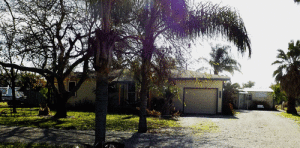
The Barr Home on Adams Street in Port O’Connor
One POC Page in the Book of Texas History
Did you know that the lighthouse on Matagorda Island was unmanned or decommissioned just before 1956? The last lighthouse keepers were Arthur and Ruth Barr. They had lived for years caring for the lighthouse. Arthur Barr was a fourth-generation lighthouse keeper. He married the lighthouse keepers’ daughter. He was a Coast Guard member before he met and married Ruth, and worked in and around the island. He knew no other life and he loved it on the island.
When the change came, they moved to Port O’Connor. They knew it would be easier when they moved to town. School was close and kids and grandkids closer, but they struggled with the move. They bought a spot to build a house in town. Mr. Barr, his best friend Mr. Lane, and a few other friends from town helped. He had the lumber shipped in one boat load at a time. Each load was limited so they would work and work on the house until that lumber was gone and then wait for another load.
They built a small frame home on the main thoroughfare we now know as Adams Street or Hwy. 185. It was very wooded and they had to clear an area to build. Finally, the house was finished and they moved to town. They raised kids and grandkids and a garden in their new spot. The house was unnoticeable from the road all the way up into the 70’s and was untouched by the developing town around it. It was a family home nestled in the trees.
Somewhere around 1997, Arthur and Ruth Barr left their POC home and moved to Port Aransas to be closer to family and help if needed. Local girl Becky Haynes bought the house and lovingly restored it to the beautiful home she enjoys now. Original features and materials were painstakingly preserved. Becky tells of treasured visits with the Barrs just after purchase when they told her some of the history of the home.
The home had survived several tropical storms and a few hurricanes, the most damaging being Hurricane Carla. The Barr family shoveled mud, sand and debris from their home more than once, but it was built to stand, so they cleaned up each time. During restoration, Becky found solidified mud and sand in wall spaces over two feet high, confirming the Barr’s account of previous hurricane survival. Becky said it hardened into concrete like blocks where it washed into and was trapped within several exterior and back porch area walls. Today, Becky’s family calls it home. Many of the trees and woods have been cleared around it, and the town has grown to be unrecognizable to the original owners of the house. It is a piece of Port O’Connor history.
The lighthouse the Barrs left behind was lit, but unmanned for years. That beautiful old lighthouse has been standing guard over Pass Cavallo for more than 150 years. When it was originally constructed in 1852, it was 92 feet tall and made completely of cast iron. It sported the customary red, white and black stripes, making it visible for miles. The Matagorda Bay entrance was key to important port cities of Port Lavaca and Indianola in 19th century America. The hurricanes of 1875 and 1876 left devastating damage in their wake and Port Lavaca became notable on the coast. The Civil War brought military conflict to the island where the lighthouse sat and Confederate soldiers broke some of the cast iron panels and hid the light lens to prevent Union soldiers from capturing or using the lighthouse during the conflict.
Repaired in 1873 and used to prevent illegal intrusion on the Gulf of Mexico, the lighthouse remained a feature of our landscape. The last functioning lens is on display at the Port Lavaca Museum. The old cemetery next to the lighthouse that was used as the final resting place for lighthouse keepers and their families remains a historic treasure. Ongoing efforts to preserve and restore its history and develop opportunities for people to experience it continue. The lighthouse is proudly listed as historically significant by the National Register of Historic Places and the Texas Historical Commission.
Arthur and Ruth Barr, their house in our community and their story remain an integral part of the lighthouse’s chapter of Texas History.
